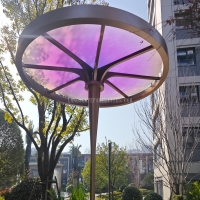Welcome to the website for landscape facilities products and knowledge.
How do landscape tables in outdoor coworking spaces address privacy needs?
Outdoor coworking spaces are gaining popularity for their fresh air, natural light, and inspiring surroundings. However, privacy remains a key concern in these open environments. Landscape tables—specially designed workstations integrated into outdoor settings—offer innovative solutions to address privacy needs while fostering collaboration.
1. Strategic Layouts for Natural Barriers
Landscape tables often incorporate organic elements like planters, shrubs, or low hedges to create subtle visual and acoustic barriers. These natural dividers help define personal workspaces without isolating users, maintaining an open yet semi-private atmosphere.
2. Height Variations and Zoning
By using tiered or staggered table heights, designers can create micro-zones within a larger space. Taller tables with integrated screens or canopies provide secluded spots for focused work, while lower communal tables encourage interaction.
3. Flexible Furniture Arrangements
Modular landscape tables allow users to reconfigure their workspace as needed. Movable partitions, adjustable shades, or sliding panels enable individuals to customize their privacy level throughout the day.
4. Material Choices for Acoustic Control
Textured surfaces, wooden accents, and fabric elements absorb sound, reducing noise distractions. Some designs incorporate water features or rustling foliage to mask conversations naturally.
5. Technology Integration
Smart landscape tables may include built-in charging stations, directional speakers, or privacy screens that double as sunshades—blending functionality with discretion.
These solutions prove that outdoor workspaces don’t require walls to ensure privacy. Thoughtful design transforms landscape tables into versatile tools that adapt to both solitary tasks and team projects, making them ideal for modern hybrid work cultures.
Related search:

Recommendation
Metal frame with gradient color acrylic combined with high-end shading landscape facilities